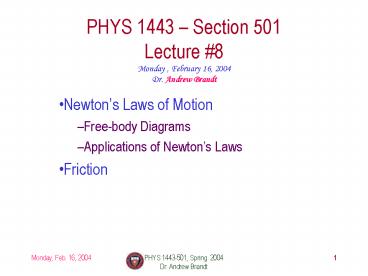PHYS 1443501, Spring 2004 - PowerPoint PPT Presentation
Title:
PHYS 1443501, Spring 2004
Description:
If two objects interact, the force, F12, exerted on object 2 by object 1 is ... Identify all the forces acting only on the selected object ... – PowerPoint PPT presentation
Number of Views:32
Avg rating:3.0/5.0
Title: PHYS 1443501, Spring 2004
1
PHYS 1443 Section 501Lecture 8
Monday , February 16, 2004 Dr. Andrew Brandt
- Newtons Laws of Motion
- Free-body Diagrams
- Applications of Newtons Laws
- Friction
2
Announcements
- Quiz results, better but not good! 72 35/41
took it - HW 3 on Ch. 4 due Weds Feb 18 at midnight
- Beware negative points
- HW4 on Ch. 5 will be due Mon Feb. 23
- If you are struggling, read text beforeafter
class, start HW eary, ask questions, physics
clinic--RM 10 - Remember the 1st midterm, Weds., Feb. 25,
- Covers chapters 1-5
3
Gravitational Force and Weight
The attractive force exerted on an object by the
Earth
Gravitational Force, Fg
Weight of an object with mass M is
Since weight depends on the magnitude of
gravitational acceleration, g, it varies
depending on geographical location.
By measuring the forces one can determine masses.
This is why you can measure mass using spring
scale.
4
Newtons Third Law (Law of Action and Reaction)
If two objects interact, the force, F12, exerted
on object 2 by object 1 is equal in magnitude and
opposite in direction to the force, F21, exerted
on object 1 by object 2.
F21
F12
The action force is equal in magnitude to the
reaction force but in the opposite direction.
These two forces always act on different objects.
What is the reaction force to the force of an
object in free fall ?
The force exerted on the Earth due the
gravitational field.
A stationary object on top of a table has a
reaction force (normal force) from the table to
balance the action force, the gravitational force.
example
5
Some Basic Information
When Newtons laws are applied, external forces
only are of interest!!
Because, as described in Newtons first law, an
object will keep its current motion unless
non-zero net external force is applied.
Why?
Reaction force that reacts to gravitational force
due to the surface structure of an object. Its
direction is perpendicular to the surface.
Normal Force, n
assume massless taut strings
The reactionary force by a stringy object against
an external force exerted on it.
Tension, T
A graphical tool which is a diagram of external
forces on an object and is extremely useful in
analyzing forces and motion!! Drawn only on an
object.
Free-body diagram
6
Free Body Diagrams
- Diagrams of vector forces acting on an object
- A great tool to solve a problem using forces or
using dynamics - Select a point on an object and w/ information
given - Identify all the forces acting only on the
selected object - Define a reference frame with positive and
negative axes specified - Draw arrows to represent the force vectors on the
selected point - Write down the net force vector equation
- Write down the forces in components to solve the
problems - No matter which object we choose to draw the
diagram on, the results should be the same, as
long as they are from the same motion
Which one would you like to select to draw
FBD? What do you think are the forces acting on
this object?
M
Normal force supporting the object exerted by the
floor
Gravitational force
Which one would you like to select to draw
FBD? What do you think are the forces acting on
this elevator?
Gravitational force
The force pulling the elevator (Tension)
Normal force
What about the box in the elevator?
Gravitational force
m
7
Applications of Newtons Laws
Suppose you are pulling a box on frictionless
ice, using a rope.
What are the forces being exerted on the box?
M
Gravitational force Fg
Normal force n
Free-body diagram
Tension force T
Total force FFgnTT
If T is a constant force, ax, is constant
Is there motion in y-direction?
8
Example of Using Newtons Laws
A traffic light weighing 125 N hangs from a cable
tied to two other cables fastened to a support.
The upper cables make angles of 37.0o and 53.0o
with the horizontal. Find the tension in the
three cables.
Free-body Diagram
Newtons 2nd law
x-comp. of net force
y-comp. of net force
9
Example w/o Friction
A crate of mass M is placed on a frictionless
inclined plane of angle q. a) Determine the
acceleration of the crate after it is released.
M
Free-body Diagram
Supposed the crate was released at the top of the
incline, and the length of the incline is d. How
long does it take for the crate to reach the
bottom and what is its speed at the bottom?
example
10
Forces of Friction
Resistive force exerted on a moving object due to
viscosity or other types of frictional
properties of the medium in or surface on which
the object moves.
These forces are either proportional to velocity
or normal force
The resistive force exerted on the object until
just before the beginning of its movement
Force of static friction, fs
Empirical Formula
Frictional force is variableas you push/pull
harder it increases until it reaches the static
limit!!
What does this formula tell you?
Beyond the limit, there is no more static
frictional force but kinetic frictional force
takes it over.
Force of kinetic friction, fk
The resistive force exerted on the object during
its movement































